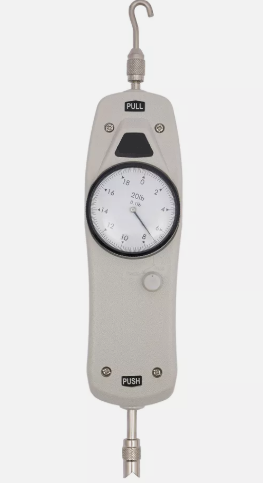
Proper fire protection starts with attention to detail, particularly when examining the gaps around doors. Facility managers and safety inspectors often purchase a door gap gauge to measure these critical spaces, ensuring that flames and smoke cannot easily spread through a building. The device, typically crafted of sturdy metal, slides along the edge of a door to measure the clearance at the top, bottom, and along the hinge side. For those keen to uphold the highest standards in fire safety, a dependable door gap gauge is an indispensable tool in their arsenal. Keep reading to discover how these simple yet vital instruments can avert common compliance issues and safeguard lives and property.

Door gap gauges serve as a critical tool for those charged with the maintenance of fire safety within buildings. By enabling inspectors and maintenance personnel to check the spaces around fire-rated doors, these devices ensure doors are properly aligned and clearances meet specified standards. The magnitude of proper door clearance in preventing smoke and fire from spreading cannot be overstressed. Knowledge of the appropriate measurements, which gauges provide, is imperative for adherence to fire safety codes of practice. Building managers and safety officials can purchase a door gap gauge not only to maintain the integrity of fire barriers but also to assure that the location and accessibility of fire extinguishers are not compromised by ill-fitting doors. Complying with fire safety regulations becomes a streamlined process when one incorporates the correct use of door gap gauges from every angle of inspection.
Door gap gauges stand as a pivotal tool within the armory of regulatory reform, acting as the engine that drives compliance across the United Kingdom. These gauges offer a tangible means of measurement, revealing when door clearances diverge from the stringent regulations that statistics show are vital to slowing the spread of fire and smoke. With the tool in hand, inspectors ensure that fire-resistant doors function as designed, safeguarding occupants and property alike.
| Fire Safety Component | Role of Door Gap Gauge | Impact on Compliance |
|---|---|---|
| Door Alignment | Measures clearance around doors | Ensures doors meet regulatory specifications |
| Smoke and Fire Spread | Checks for uniform gaps | Limits the progression of fire and smoke |
| Fire Barrier Integrity | Assesses the fit of fire-rated doors | Maintains effectiveness of fire containment strategies |
The integrity of door clearances in a building’s architecture is a paramount factor in upholding fire safety standards. Adequate clearance ensures that fire-rated doors function with the precision necessary to contain fire and smoke, reducing the risk of propagation that can be exacerbated by issues related to electricity, irregular weight distributions, or poor workmanship. Valid certification of these clearances is not only a legal mandate but also an assurance of the safety measures in place, where the price of precision is ultimately far lower than the cost of negligence, especially in critical escape routes such as stairs.
In the intricate tapestry of fire safety, door gap gauges emerge as potent instruments for warehouses storing dangerous goods. Ensuring fire doors have the correct clearances, these gauges are indispensable in preventing the rapid spread of fire, thereby facilitating compliance with stringent regulations. Brands cognizant of their role in public safety do not skimp on such measures, often advertising their commitment to such standards as a testament to their responsibility and ethical standing.
Recognizing the importance of door gap gauges is just the beginning. Let’s walk through the practical steps of using a fire door gap gauge effectively.

Securing comprehensive fire safety within an establishment necessitates precise measurement and adjustment of fire door gaps. The selection of an appropriate door gap gauge is pivotal, with options available for varying door types, including those with latches or embedded glass panels. Once in possession of the suitable gauge, the task follows to accurately measure the spaces along the top, sides, and bottom of fire doors. This process determines whether the clearance falls within the recommended percentage range to prevent the perilous passage of smoke and flames. The final stage involves a thorough risk assessment, interpreting the measurement findings to affirm that the doors are up to code and provide the expected level of protection. Here the accurate use of a door gap gauge becomes not just a matter of compliance, but a safeguard against the risks fire poses to life and property.
Selecting the right door gap gauge involves a keen understanding of the doorway’s attributes, considering factors such as whether the door contains a mirror, necessitates a box-shape tool for square edges or needs a slimmer gauge that can glide easily into tight spaces. The chosen gauge must allow maintenance personnel and fire department inspectors to assess whether a door‘s gaps adhere to safety standards after the application of paint or other finishes which may affect the door‘s clearance. It should subscribe to the ease of use and accuracy required for swift yet thorough inspections.
To measure door gaps with precision, compliance with British Standards is essential for safety. Inspectors typically use a computer or similar electronic device to record data, ensuring meticulous accuracy. Such a process is akin to using a web browser to navigate the internet—a precise tool for exploring and recording the dimensions crucial for preventing fire and smoke passage.
| Inspection Step | Action | Compliance With British Standards |
|---|---|---|
| Initial Assessment | Review door components | Verify that all parts align with safety criteria |
| Electronic Measurement | Use computerized tools for data recording | Ensure precision in gap measurement |
| Environmental Factors | Assess the impact of nearby radiator heat on door expansion | Adjust measurements to account for temperature fluctuations |
Upon completion of gap measurements, interpreting the data against required standards ensures that the door will function as an effective barrier in case of fire. Tolerances often allow for a small margin; however, the presence of intumescent seals that expand when exposed to heat must be considered, potentially affecting the margin. An inch might seem insignificant, but in the context of fire resistance, it can determine whether a plastic or wood door becomes a hazard or maintains its integrity under duress.
Ensuring the proper function of fire doors is paramount for safety. Door gap gauges play a pivotal role in addressing common compliance issues.

In the quest for fire safety and regulatory adherence, door gap gauges are an invaluable asset for pinpointing and rectifying common door clearance issues. Addressing oversized door gaps is crucial, as excessive space can accelerate the spread of heat and combustion, undermining the protective purpose of fire-resistant barriers. Conversely, undersized gaps may cause increased friction, impairing door operation and potentially warping the door leaf under prolonged pressure. To ensure the efficacy of fire containment strategies within buildings, it is vital that gap measurements are consistently executed across all facilities. Such precision serves to uphold the integrity of fire safety measures, offering reassurance that in the critical moment, door assemblies will perform as necessary to thwart the passage of smoke and flames.
Oversized door gaps represent a direct threat to the integrity of fire protection in any building. When the clearance around a door exceeds specifications, the result can be as dangerous as oil fueling a blaze—swiftly guiding smoke and flame along a wall or through a structure. Making use of door gap gauges for precise measurement allows maintenance teams to identify these gaps early, ensuring that interventions can be applied, such as installing additional steel or water barriers to mitigate risk.
| Problem Identified | Measurement Tool | Immediate Risk | Long-term Solution |
|---|---|---|---|
| Excessively wide door gaps | Door gap gauge | Increased fire and smoke propagation | Installation of steel or water barriers to reduce clearance |
Undersized gaps, a frequent oversight in construction, require immediate attention to ensure adherence to fire safety standards. Constant inspection of door clearances mitigates impaired functionality, balancing the need for tight seals against the risk of obstruction during emergencies.
In the realm of fire safety, ensuring consistent measures of door gaps across an establishment’s facilities is an exercise in precision and uniformity that significantly lowers the risks during an emergency. Incorporating best practices includes regular checks on doors with glazing, which may require specialized attention due to the materials involved. Observing the law to the letter is akin to the systematic workings of a vehicle, each part functioning harmoniously to achieve the desired outcome: optimal safety.
| Facility Inspected | Type of Door | Glazing Present | Compliance Status | Required Action |
|---|---|---|---|---|
| Main Office Building | Fire-rated with glass panels | Yes | Non-compliant | Adjust door to adhere to gap specifications |
| Warehouse Unit A | Steel without glazing | No | Compliant | Regular monitoring for maintenance |
| Vehicle Storage Garage | Overhead roll-up fire doors | No | Non-compliant | Realign tracks for consistent gaps |
Transitioning from one crucial topic to another, let’s examine the variety of fire door gap gauges available. Each has a purpose crafted to keep buildings safe and up to code.

In the intricate landscape of fire safety, selecting an appropriate door gap gauge emerges as more than a trivial pursuit; it stands as an exercise in precision and practicality, striking a balance between traditional methods and contemporary technological advances. Analog door gap gauges, with their direct, tactile approach, contrast sharply with their digital counterparts that boast sophisticated data logging and communication capabilities. Bearings, indispensable in maintaining accuracy under repetitive use, feature prominently in these devices, enhancing their longevity and reliability. Specialized gauges cater to distinct door types, including those with unconventional designs, glass panels, or embedded wiring, ensuring fire barriers remain uncompromised. For maintenance personnel, understanding the full spectrum of available tools is vital in choosing a gauge tailored to their specific needs, fusing the elements of data precision, structural integrity, and efficient communication in the pursuit of steadfast compliance with fire safety regulations.
Equipped with the knowledge of various fire door gap gauges, safety professionals can now turn to their practical integration. Ensuring frequent inspections with the right tools becomes not just a protocol, but a steadfast commitment to safety.

In the realm of fire safety, the meticulous use of door gap gauges is paramount for ensuring compliance with regulations. Critical to this endeavor is the creation of a detailed fire door inspection schedule, a structured approach empowering organizations to regularly assess the functional state of their fire barriers. Organizations must ensure that their staff are proficient in using these tools, necessitating targeted training programs that address the nuances of door gap gauges. Accurate documentation is equally essential, as it enables the tracking of inspections and facilitates prompt rectification of any compliance issues. Properly executed, these measures collectively form a robust strategy for maintaining the highest standards of safety and readiness against the threat of fire.
Establishing a comprehensive fire door inspection schedule is a strategic approach to fire safety management that involves delineating regular intervals for assessing the condition and compliance of fire-rated doors. Such a schedule is typically designed to align with the unique risk profile and operational demands of the facility, ensuring that inspections are conducted frequently enough to address any potential safety concerns swiftly while causing minimal disruption to daily activities.
Training initiatives for staff highlight the practical applications of door gap gauges, underpinning critical protocols for fire safety. These sessions, tailored to the skill level and responsibilities of the participants, reinforce the correlation between precise gap measurements and the efficacy of fire containment measures. Staff emerge from training not only knowledgeable but also capable of confidently executing inspections that undergird an establishment’s regulatory compliance and safety directives.
Meticulous record-keeping is a cornerstone of ensuring fire doors maintain their regulatory compliance; each inspection, facilitated by the precise use of door gap gauges, is methodically documented to form an audit trail. This attention to detail enables facilities to quickly identify and rectify discrepancies, strengthening the integrity of fire safety measures and safeguarding occupants against potential hazards.
Perfecting the use of door gap gauges calls for expert techniques beyond the basics. Move on to advanced tips to ensure your measurements hit the mark every time.

Maintaining the utmost precision with door gap gauges is a pivotal aspect of fire safety compliance, which hinges on accurate measurements and reliable equipment. Regular calibration and meticulous maintenance of gauges are essential to ensure they provide trustworthy readings. Professionals conducting measurements must remain vigilant to circumvent common errors that could compromise door integrity and, consequently, building safety. Furthermore, harnessing advanced technological solutions can greatly enhance accuracy, fostering a culture of impeccable compliance while streamlining the processes involved in door gap inspections.
Regular calibration and scrupulous maintenance of door gap gauges are indispensable for accurate assessments in fire safety inspections. Professionals gauge the alignment and tension of their tools to guarantee that every measurement reflects the true state of door spaces, averting disastrous consequences that could arise from inaccurate data. Ensuring these instruments are kept in optimal working condition involves routine checks and calibration against recognized standards:
Accuracy in fire door gap assessments hinges on avoiding common deviations; practitioners must ensure the gauge is perpendicularly aligned to the door when taking measurements to prevent skewed results. Vigilance is key during the assessment process to ensure that environmental factors such as temperature or humidity, which might impact the door‘s material and alter gap sizes, do not go unnoticed—thereby maintaining the validity of recorded data. Consistent methods, precise alignment, and careful consideration of environmental variables are the bedrock of dependable door clearance evaluations.
Leveraging technological advancements in the design and deployment of door gap gauges ensures enhanced precision in fire safety inspections. Smart gauges equipped with sensors and connectivity capabilities enable seamless data transfer to central monitoring systems, facilitating real-time oversight and trend analysis. Such technologies transform door gap measurement into a highly accurate and efficient process, underpinning proactive fire safety management strategies.
Door gap gauges play an indispensable role in upholding fire safety standards, enabling precise verification of fire-rated door clearances. Their use ensures that doors operate effectively to contain the spread of fire and smoke, protecting property and lives. Regular inspection and measurement with these tools are essential for maintaining compliance with safety regulations. Ultimately, integrating door gap gauges into safety protocols is a vital step in mitigating fire risks within any establishment.



Measuring door pressure is acting in compliance with building regulations, like the Americans with Disabilities Act (ADA). It’s an important step in ensuring accessibility, safety

When talking about building safety, the first things that come to mind are fire alarms, emergency exits and security systems. Meanwhile, the one tool that